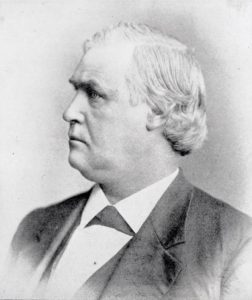
(Apr. 12, 1824-Mar. 9, 1905). Born near McKeesport, Pennsylvania, Caven attended a primitive log school. He worked as a laborer in his father’s salt works, and in barging and coal mining, leaving home just before age 21. He reached Indianapolis in September 1845, clerked in a shoe store for two years, then began the study of law in the office of Smith and Yandes. After a year in the coal business in Clay County, he returned to Indianapolis in 1851 or 1852 and opened a law practice with .
Elected to office a record five times, the first three unopposed, Caven served longer than any other mayor until (1976-1991). Unlike his predecessors, Caven saw the mayor’s role as leader and initiator. His first terms were marked by his drafting a street railway charter and inducing the parties to come and build it, by the printing of the council proceedings, and by the introduction and adoption in 1866 of an eight-hour ordinance for city workers. In his terms in the legislature (1869, 1871, 1887) Caven took a leading role in securing schools for Black children, creating the city library, authoring the law establishing bipartisan election boards, and drafting a mechanics lien bill that was adopted after his service.
His last three terms as mayor coincided with the worst years of the depression of the 1870s and the dangerous social conflict it aroused. Caven exhibited genuine statesmanship: in May 1876, his intervention ended an election day race riot; in June 1877, he prevented a “blood or bread” uprising. Eliciting promises of no violence from a mass meeting of jobless workmen, Caven led a procession to the city’s bakeries and distributed the bread at his own expense. He made good his promise that hundreds would find work the next day on the construction of the and Union . That project, whose bonds were guaranteed by the city, had been Caven’s idea in 1876. When the great , reached Indianapolis, Caven’s decision to enroll hundreds of striking railroad men as special deputies prevented the widespread property destruction and loss of life experienced elsewhere.
Caven suffered financially after 1873, but recovered by the end of the decade. After his last stint as mayor, Caven became president and a director of the Indianapolis Brush Electric Light and Power Company, incorporated in 1881, which proposed to light the city with electricity. Had the city council agreed to his plan, Indianapolis would have become one of the first cities in the world so lighted. In 1892 the Brush Company merged with others to form the . Caven served as vice president and a director until 1896 when he sold his interests.
After his retirement, and before his health failed two years before his death, Caven often took long walks about the city. With a full beard and hair to his shoulders, completely white, his appearance was patriarchal. An assiduous Freemason and clubman, Caven never married.

Help improve this entry
Contribute information, offer corrections, suggest images.
You can also recommend new entries related to this topic.